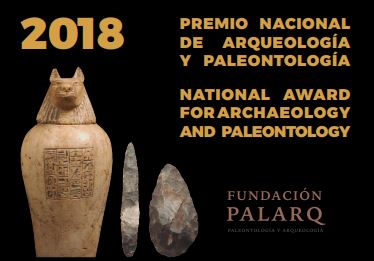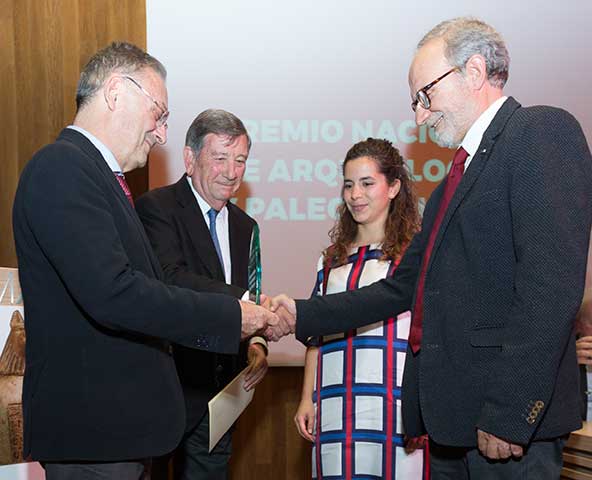The first hecatomb documented in the Mediterranean
Its objective is the architectural study of the constructions of the Tartessian period (8th-5th century BC). The excavations of the site of Casas del Turuñuelo (Badajoz), to date the best-preserved protohistoric building in the western Mediterranean, are inserted within this framework, as it maintains its two floors, making it an exceptional case study.
In spite of the fact that only four years have been intervened, the site has had an enormous repercussion given the new constructive techniques used in its construction, among which the use for the first time in our peninsula of the lime mortar for the manufacture of the ashlars with which the monumental staircase that connects the superior floor with the patio was erected.
Added to all this is the identification of a great sacrifice of animals, among which the 52 equids found in an anatomical position stand out, that is to say, with the parts of the body where it corresponds, being the first documentation of a hecatomb in the whole Mediterranean.
Read the article written by the winners here.
Project title: Building Tartesos: Spatial, constructive and territorial analysis of an architectural model in the middle valley of Guadiana
Institution: Instituto de Arqueología (CSIC-Junta de Extremadura)
Principal Investigator: Dr. Sebastián Celestino Pérez and Dr. Esther Rodríguez González, researchers at the Instituto de Arqueología (CSIC-Junta de Extremadura)
Summary: The Project of the National R & D Plan, “Construyendo Tartesos”, has as objective the architectural study of the constructions of Tartessian period (8th-5th century BC).
The excavations of the site of Casas del Turuñuelo (Badajoz), to date the best-preserved protohistoric building in the western Mediterranean, are inserted within this framework, as it maintains its two floors, making it an exceptional case study. In spite of the fact that only four years have been intervened, the site has had an enormous repercussion given the new constructive techniques used in its construction, among which the use for the first time in our peninsula of the lime mortar for the manufacture of the ashlars with which the monumental staircase that connects the superior floor with the patio was erected.
Added to all this is the identification of a great sacrifice of animals, among which the 52 equids found in an anatomical position stand out, that is to say, with the parts of the body where it corresponds, being the first documentation of a hecatomb in the whole Mediterranean. These circumstances, in addition to the richness of the materials found, have led to the creation of a multidisciplinary team of stature to undertake the enormous challenge posed by its study.
Finalists:
Project title: Paleobiology and evolution of the Neandertals of El Sidrón (Asturias)
Institution: MNCN (Museo Natural de Ciencias Naturales)-CSIC
Principal Investigator: Dr. Antonio Rosas González, Department of Paleobiology, Museo Nacional de Ciencias Naturales, CSIC
Abstract: The project “Paleobiology and Evolution of the Neanderthals of El Sidrón” studies the large collection of fossils of the species Homo neanderthalensis recovered in the aforementioned site, suitable for the advance in understanding the complex universe of these humans so close to us. The sample consists of more than 2,500 remains from a family group of 13 individuals of both sexes and different ages. Under the direction of CSIC Research Professor Antonio Rosas, the Paleoanthropology Group of the National Museum of Natural Sciences has been developing for years several lines of research on multiple aspects of the life of Neanderthals. The results obtained have been published in high impact journals and have shed new light on their diet, typical of forest environments, their physiology and growth, generally similar, but not identical to that of modern humans, their pathologies, paleoneurology, demography, cannibalism, etc. One of the most notable contributions of this project has also been its role in the recent paleogenetic revolution, participating in the international project Neanderthal Genome.
Project title: ORIGINS OF AGRICULTURE AND LIVESTOCK IN THE NEXT EAST: Study and Analysis of a historical phenomenon in Syria and Iraqi Kurdistan
Institution: Universidad Autónoma de Barcelona
Principal Investigator: Dr. Miquel Molist Montaña, Professor, Department of Prehistory, Universidad Autónoma de Barcelona
Abstract: The processes of agricultural and livestock domestication have in the area of the Near East one of their preferential contexts of study. Paleoclimatic, paleoecological and archaeological evidences allow us to approach the complex transformation processes of human societies, where anthropic inference is complemented by technological, material and symbolic diversity. In this direction, the project presented focuses on the study of the important technological innovations that take place between 10,000 and 4,000 cal BC, covering the entire Neolithic period until the emergence of the Mesopotamian state systems. The possibilities of studying these processes in large regions such as Syria, Turkey and Iraq, and with an archaeological database of more than 30 years of compilation, will validate the new archaeological and analytical work carried out in relation to the complexity of the neolithization, from the Near East to Mediterranean Europe.
Project title: Bastida Project
Promotional video of the archaeological site of La Almoloya Audiovisual sponsored by Pliego Town Hall
Institution: Department of Prehistory, Universidad Autónoma de Barcelona
Principal Investigator: Dr. Vicente Lull, Dr. Rafael Micó, Dr. Cristina Rihuete Herrada and Dr. Roberto Risch
Summary: The “Bastida Project” has unveiled one of the first European civilizations, the so-called society of El Argar, which developed in the southeast of the peninsula about 4000 years ago. The recognition of an urban and state society in the western Mediterranean at the beginning of the Bronze Age has revolutionized the scenario of recent European prehistory. For the last 10 years, the main excavations have focused on three archaeological sites in Murcia: La Bastida and Tira del Lienzo (Totana), and La Almoloya (Pliego-Mula). Among the most important discoveries are the monumental fortification of the “Troy of the West” in La Bastida and the building of the “First European Parliament” in La Almoloya. Both have been highlighted among the most important worldwide by media such as National Geographic.
Ongoing interdisciplinary research includes DNA, paleoeconomic and paleoecological analyses to advance knowledge of one of the earliest urban societies in the West.
Project title: THE FIRST HUMANS. ARCHEOLOGY OF THE DEPOSITS OF BED I OF THE THROAT OF OLDUVAI (TANZANIA): FLK ZINJ, DS, PTK AND AGS
Institution: Instituto de Evolución en África (IDEA), Universidad de Alcalá de Henares
Principal Investigator: Dr. Manuel Domínguez Rodrigo, Universidad Complutense, Dept. Prehistory, Ancient History and Archeology, IDEA, Universidad de Alcalá.
Dr. Enrique Baquedano, Museo Arqueológico Regional de la Comunidad de Madrid, Alcalá de Henares, IDEA,Universidad de Alcalá
Summary: The research project directed by Manuel Domínguez Rodrigo and Enrique Baquedano on the lower bed, the oldest in the Olduvai Gorge (Tanzania), is a continuation of the tasks initiated by the famous Leakey saga in the place known as “Cradle of humankind”, according to the UNESCO denomination. The work of this team focuses on the study of the appearance and evolution of the first representatives of the genus Homo. And very specially in the analysis of the behavior that defines it as characteristic of our gender. The sites in which it intervenes are unanimously considered as the best preserved places for the study of behavior in our first ancestors. It can be said that these sites and their research are key to understanding how we become human.
The team is also especially recognized internationally for its studies of archaeological taphonomy and for being a pioneer in the use of artificial intelligence tools.
Institution: Instituto Universitario de Investigación en Arqueología Ibérica de la Universidad de Jaén
Principal Investigator: Dr. Juan Pedro Bellón Ruiz, investigador del Instituto Universitario de Investigación en Arqueología Ibérica, Universidad de Jaén
Abstract: The ILIT · AURO Project is the result of a long line of research on the Archaeology of Conflict, focused on the archaeological analysis of the Second Punic War. Thanks to avant-garde methodology, the project has managed to locate and analyze the Baecula Battlefield, where in the year 208 BC, Scipio the African and Asdrúbal Barca faced each other. This first result is the basis of our line in two senses: it has allowed us to recognize for the first time the spatial scale of a confrontation of the Second Punic War and, secondly, it has provided us with a corpus of reference materials for the identification of new scenarios linked to that war episode.
The project has been developed in the analysis of the siege of Scipio Africanus to the Iberian city of Iliturgi, in the year 206 BC, siege that has been identified thanks to the combined use of Geographical Information Techniques and the own archaeological prospection and excavation.
Finally, its international projection has a first trial in the south of Italy, thanks to a project financed by the Institute of Cultural Heritage of Spain, in its program of Excavations Abroad (Project Numistro) and, at present, we are initiating fieldwork for the location of the Battle of the Metauro, linked to Baecula through Asdrúbal Barca, just one year after that.
We are interested in analyzing war archaeologically, from an interdisciplinary point of view, recognizing the ‘voids’ left by written sources and trying to evaluate the real consequences of these violent episodes for the communities affected by them.








